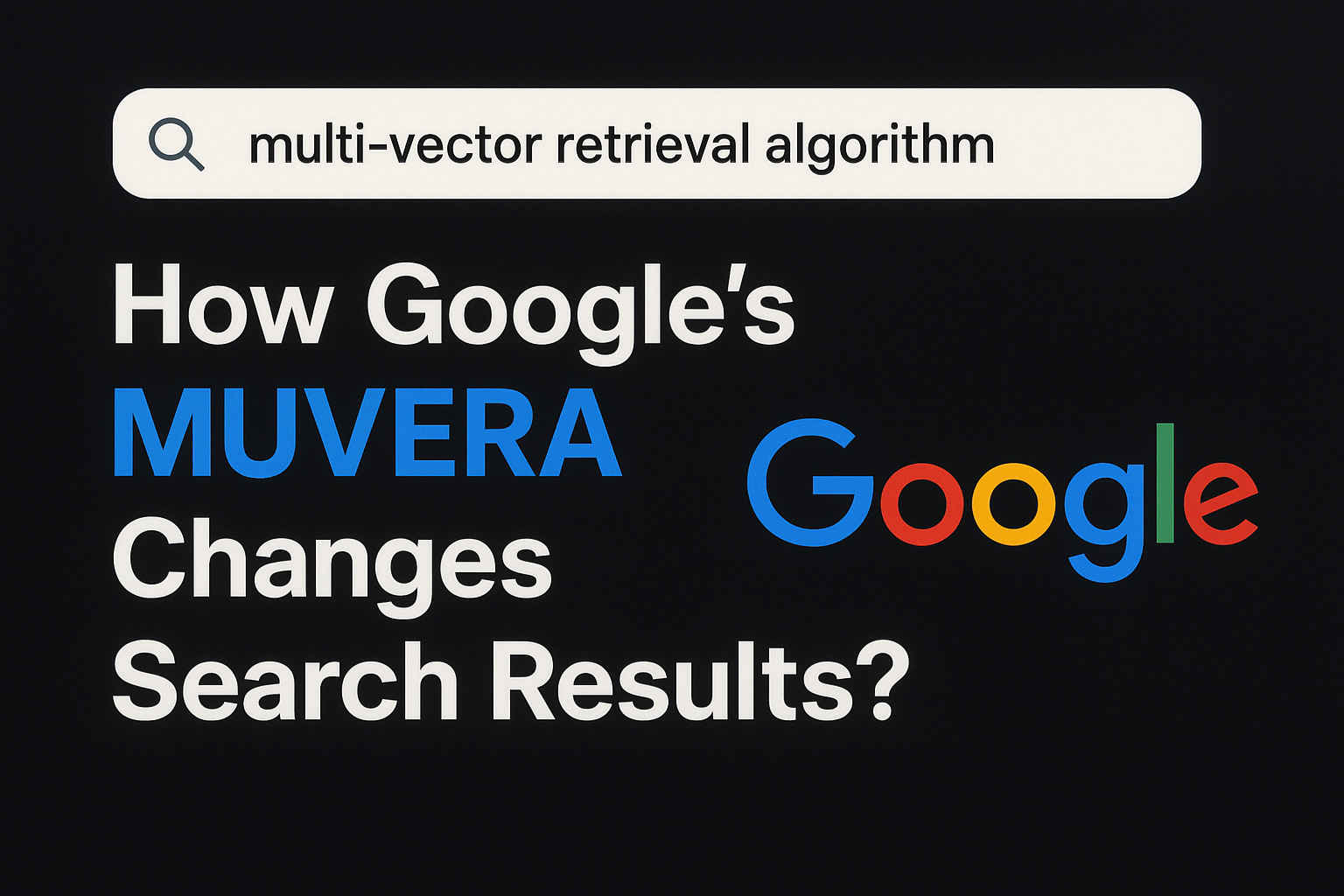Google’s algorithm landscape in 2025 is undergoing a significant transformation. Major core updates have for long disrupted rankings through adjustment of signals like content quality and backlinks. All of that now looks to undergo significant alteration, thanks to MUVERA algorithm. MUVERA algorithm, at times called in industry reporting as ‘MOVERA, personifies a deeper transformation. That is, how content is retrieved in the first place. Traditional updates after retrieval tend to re-rank pages. MUVERA on the other hand, restructures the retrieval layer itself. This will now determine which passages are even considered for ranking. MUVERA leverages multi-vector passage-level embedding. This means each content block or section on a page will now be represented individually and indexed. Earlier, the whole page used to be represented individually and indexed. The new developments in SEO terms means your content would now need to survive not just ranking evaluation, but also retreivability filtering Google could if the passage fails to signal clear intent or structure, ignore it-even if the whole page is well-ranked.
WHAT IS MUVERA? WHY IT MATTERS?
MUVERA in full form means “Multi-Vector Retrieval Via Fixed-Dimensional Encodings.” It’s a big shift to multiple passage-level vectors from single-vector document representation.
These vectors
- Encode within a page subtopics or distinct intent blocks.
- Allow richer semantic retrieval. Even with compressed index size.
HOW IT WORKS?
- Google breaks a page into modular sections.
- Each section gets own dense vector embedding.
- Each section compresses these vectors with product quantization (32x smaller memory). At the same time, they retain high recall.
- Finally, only the most semantically relevant passages are retrieved. Not every page that marginally matches a query.
Earlier marginal matching pages before MUVERA’s entry used to be included for ranking in the candidate pool. But that’s going to change as now poorly structured or generic content could never be retrieved. This will make from here on retrieval optimization equally important.
HOW MUVERA FITS INTO GOOGLE’S BROADER SEO EVOLUTION?
Google has shifted its SEO focus to deeper semantic and AI understanding (hummingbird, BERT, MUM, RankBrain). Earlier its focus was on keyword-matching (Panda, Penguin). Recent content updates, that is, 2022-24 and core updates (March 2025 & June 2025) placed emphasis on user intent, content quality, and user satisfaction signals. MUVERA builds on that by ensuring only when content explicitly serves that intent the retrieval happens.
WHAT MUVERA MEANS FOR SEO STRATEGY?
1. STRUCTURE FOR RETRIEVABILITY
Your content must be flexible and adapt to the requirements of the situation. This will encourage Google to extract discrete intent blocks.
- Use clear headings (H2/H3). They should be labeled with natural intent cues. Like for instance, “How to Charge EV Batteries”; or “Best Budget Digital Cameras.”
- Divide long articles into distinct sections. With each answerable to a query.
- Format key segments as easily retrievable passages. Like FAQs; Bullet-Lists; Mini-Summaries.
Your content page may without this structure not register at all for specific queries, even if it ranks elsewhere.
2. CONTENT DEPTH & SEMANTIC TOPICAL AUTHORITY
Your content must cover its topic comprehensively in depth. MUVERA rewards topics with comprehensive coverage. So make sure to
- Supply
– Full contexts.
– Comparisons’.
– Use cases.
- Build semantic clusters. Later answer primary queries; and finally, related sub-queries within the same page.
- Link internally to deeper articles on subsidiary themes.
This will seamlessly align with prior focus on topic clusters and topical authority. That’s reinforced by retrieval criteria.
3. CONTENT-DRIVEN OPTIMIZATION OVER KEYWORD DENSITY
Content that is keyword-stuffed or superficially thin will likely be discarded at retrieval. So, focus on
- Optimizing naturally around long-tail, conversational queries.
- Addressing implied intents in content. That is, what users expect next in their journey.
- Avoid the use of generic introduction and skip fluff. Instead, aim to include useful content.
4. EVIDENCE OF EXPERIENCE (E-E-A-T)
Google is increasingly getting smarter. This is best highlighted by the fact it’s now more adept in evaluating genuine experience rather than just on authoritativeness (E-A-T).
HOW TO ADAPT TO THIS TREND?
- Present unique context. Rather than regurgitated information,
- Include real-world examples. Like testimonials, case studies.
- Use author bios. With links and credentials.
MUVERA can identify distinct expressions and real insights. This helps to boost the potential of credible content retrieval.
5. MULTIMEDIA AND STRUCTURED DATA
Google will now place more emphasis on AI-mode and mixed-media SERPs.
HOW TO ADAPT?
- Embed optimized
– Image
– Video
– Table
– Infographics
- Use schema markup. Like FAQ, How-To, Product.
- Structure content. This will allow AI to easily extract key facts, like FAQ sections.
MUVERA retrieves semantically rich representations. Additionally, multimodal content is now more likely to yield useful embeddings.
HOW MUVERA CHANGED RANKING SIGNALS POST-UPDATE JUNE 2025 CORE UPDATE?
Google beginning 30th June, 2025 rolled out broad core update. It included both MUVERA and Graph Foundation Model Integration. The focus was to enhance retrieval and trust mapping. SEO practitioners following these rollouts reported,
- Sites previously hit by helpful content penalties rebounded. If they fixed structure and experience signals.
- Less volatility overall. But more emphasis on semantic match and satisfaction.
MARCH 2025 & EARLIER CORE UPDATES
Earlier updates (March 2025) penalized with low moderation templated programmatic content and forums. At the same time, Google rewarded engagement, multimedia, and comprehensive articles. MUVERA builds on those by filtering retrieval.
PRACTICAL GUIDELINES FOR SEO TEAMS
STEP 1: CONTENT AUDIT AND MODULARIZATION
- Audit existing long-form pieces. Like, do headings clearly map to discrete questions or intents?
- Refactor overlapping or superficial sections. Into standalone clearly labeled blocks.
- Create or revise FAQ and TL:DR sections for retrieval.
STEP 2: DEEPEN & ENRICH CONTENT
- Expand topic clusters. Answer within the same page follow-up questions.
- Incorporate
– Case Study
– Real Data
– Examples
– Visuals
- Avoid ‘fluff’. Or general intros. Get direct with useful content.
STEP 3: SIGNAL EXPERIENCE & CREDIBILITY
- Add author bios with
– Credentials
– Real-world backgrounds.
– Professional affiliations.
- Surface quotes, testimonials, reviews, or experiential narratives.
- Link to certifications, original research, or external authoritative references.
STEP 4: OPTIMIZE FOR MULTIMODAL RETRIEVAL
- Use optimized images. With alt-text and captions.
- Embed videos. Or infographics where relevant.
- Apply structured data. For FAQ, How-To, Product, or Event Types.
STEP 5: MONITOR RETRIEVAL VISIBILITY
- Track query-to-passage matching. Like, which queries bring snippets from your pages?
- User Search Console. To see if your contact is included in ‘rich results’ or AI Mode features.
- A/B test structured VS unstructured formats.
COMMON PITFALLS UNDER MUVERA
- GENERIC LONG-FORM LOSING OUT: Avoid having a piece with a dense collection of text sans signal structure. They risk being not retrieved.
- THIN FAQs or TEMPLATED Q&A: Too formulaic or auto-generated Q&A sections. Risk suffering under MUVERA’s intelligence.
- KEYWORD-HEAVY INTROS: Opening paragraphs stuffed with keywords harms retrieval signals. Instead, use natural user phrasing.
- DISJOINTED STRUCTURE: Mixing unrelated subtopics under vague headings. Makes embedding less meaningful.
- LACK OF AUTHORSHIP/AUTHENTICITY: Content with no clear voice or evidence of real experience. Could be considered superficial.
BENEFITS OF ADAPTING TO MUVERA-AWARE SEO
- INCREASED INCLUSION IN AI-DRIVEN SERP FEATURES: AI Mode and AIOs tend to source from precisely retrievable passages.
- BETTER RANKING RESILIENCE: Even if ranking signals shift, passages clearly aligned to intent will retain visibility.
- SUPERIOR USER SATISFACTION: Structured modular content. Tends to keep readers engaged. They also reduce bounce.
- COMPETITIVE EDGE: Many websites remain still stuck in headline-plus-body format. This gives you advantage.
➡️ Read More : HOW LONG IT TAKES FOR SEO AS PER GOOGLE TO WORK?
Know More About Our Different Locations
Digital marketing agency Abu Dhabi
Digital Marketing Agency in India
Digital Marketing Company in Dubai
CONCLUSION
SEO is in 2025 and beyond no longer just about ranking signals. It’s more about whether Google sees your content at all. The barrier with MUVERA becomes retrievability. If your content is not properly represented, that is, richly structured and intent-aligned, Google may never include it in search candidates. To stay in Google’s good books, focus on,
- Modular, intent-based content structure.
- Demonstrable experience and authenticity.
- Depth and semantic authority.
- Multimedia and structured markup.
If done accordingly, Google will position your content for retrieval visibility and AI-driven SERP features.














